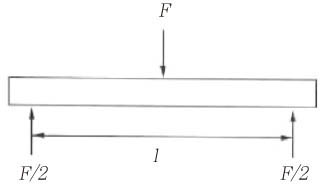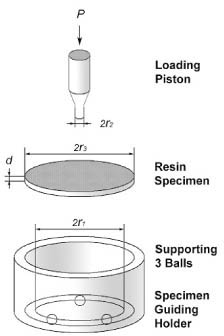J Korean Acad Conserv Dent.
2006 Jan;31(1):58-65. 10.5395/JKACD.2006.31.1.058.
The comparison of relative reliability on biaxial and three point flexural strength testing methods of light curing composite resin
- Affiliations
-
- 1Department of Conservative Dentistry, College of Dentistry, Yonsei University, Korea. operatys16@yumc.yonsei.ac.kr
- KMID: 2175786
- DOI: http://doi.org/10.5395/JKACD.2006.31.1.058
Abstract
- The possibility of applying a bi-axial flexure strength test on composite resin was examined using three point and bi-axial flexure strength tests to measure the strength of the light-cured resin and to compare the relative reliability using the Weibull modulus. The materials used in this study were light-curing restorative materials, MICRONEW(TM), RENEW(R) (Bisco, Schaumburg, USA). The bi-axial flexure strength measurements used the piston-on-3-ball test according to the regulations of the International Organization for Standardization (ISO) 6872 and were divided into 6 groups, where the radius of the specimens were 12 mm (radius connecting the 3-balls: 3.75 mm), 16 mm (radius connecting the 3-balls: 5 mm), and the thickness were 0.5 mm, 1 mm, 2 mm for each radius. The bi-axial flexure strength of the MICRONEW(TM) and RENEW(R) were higher than the three point flexure strength and the Weibull modulus value were also higher in all of the bi-axial flexure strength groups, indicating that the bi-axial strength test is relatively less affected by experimental error. In addition, the 2 mm thick specimens had the highest Weibull modulus values in the bi-axial flexure strength test, and the MICRONEW(TM) group showed no significant statistical difference (p > 0.05). Besides the 2 mm MICRONEW(TM) group, each group showed significant statistical differences (p < 0.05) according to the thickness of the specimen and the radius connecting the 3-balls. The results indicate that for the 2 mm group, the bi-axial flexure strength test is a more reliable testing method than the three point flexure strength test.
MeSH Terms
Figure
Cited by 2 articles
-
Comparison analysis of fracture load and flexural strength of provisional restorative resins fabricated by different methods
Won-Tak Cho, Jae-Won Choi
J Korean Acad Prosthodont. 2019;57(3):225-231. doi: 10.4047/jkap.2019.57.3.225.Flexural strength and microstructure of two lithium disilicate glass ceramics for CAD/CAM restoration in the dental clinic
Suk-Ho Kang, Juhea Chang, Ho-Hyun Son
Restor Dent Endod. 2013;38(3):134-140. doi: 10.5395/rde.2013.38.3.134.
Reference
-
1. Anusavice KJ, Hojjatie B. Stress distribution in metal ceramic crowns with a facial porcelain margin. J Dent Res. 1987. 66:1493–1498.
Article2. Zidan O, Asmussen E, et al. Tensile strength of restorative resins. Scand J Dent Res. 1980. 88:285–289.
Article3. Bryant RW, Mahler DB. Modulus of elasticity in bending of composites and amalgams. J Prosthet Dent. 1986. 56:243–248.
Article4. Radford KC, Lange FF. Loading factors for the biaxial flexure test. J Am Ceram Soc. 1978. 61(5-6):211–213.5. Han BS. Al2O3 selamigseu-ui yeolchunggyeog pagoe geodonggwa yeol-eunglyeog haeseog. 1997. Yeonsei Univ. Graduate School;doctorate thesis.6. Mckinney KR, Herbert CM. Effect of surface finish on structual ceramic failure. J Am Ceram Soc. 1970. 53:513–516.7. Kirstein AF, Woolley RM. Symmetrical bending of thin circular elastic plates of equally spaced point supports. J Res Nall Burstds. 1967. 71(C):1–10.8. Kao R, Perrone N, Capps W. Large-deflection solution of the coaxial-ring-circular-glass-plate flexure problem. J Am Ceram Soc. 1971. 54:566–571.
Article9. Shetty DK, Roesinfield AR, Duckworth WH, Held PR. A Biaxial-flexure test for evaluating ceramic strength. J Am Ceram Soc. 1983. 66:36–42.10. Marshall DB. An improved biaxial flexure test of ceramics. Am Ceram Soc Bull. 1980. 59:551–553.11. Lamon J. Statistical approaches to failure for ceramic reliability assessment. J Am Ceram Soc. 1988. 71:106–112.
Article12. Wilshaw TR. Measurement of tensile strength of ceramics. J Am Ceram Soc. 1968. 51:111–117.
Article13. Park SE. Biaxial fracture behavior and simulation for prediction of fatigue lifetime in alumina by ball-on-3ball test. 2000. Yeonsei Univ. Graduate School;doctorate thesis.14. Shetty DK, Roesinfield AR, Macguire P, Bansal GK, Duckworth WH. Biaxial flexure tests for ceramics. Am Ceram Soc Bull. 1980. 59(12):1193–1197.15. Shetty DK, Roesinfield AR, Bansal GK, Duckworth WH. Biaxial fracture stuies of a glass-ceramic. J Am Ceram Soc. 1981. 64(1):1–4.16. Williams RM, Swank LR. Use of Weibull statics to correlate MOR, Ball-on-ring, and rotational fast fracture tests. J Am Ceram Soc. 1983. 66(11):756–768.17. Ham-Su R, Wilkinson DS. Strength of tape cast and laminated ceramics. J Am Ceram Soc. 1995. 78(6):1580–1584.
Article18. Chiang MYM, Tesk JA. Differences: Hertz vs finite element calculation for diametral tensile strength. J Dent Res. 1989. 68:341–348.19. Ban S, Anusavice KJ. Influence of test method on failure stress of brittle dental materials. J Dent Res. 1990. 69(12):1791–1799.
Article
- Full Text Links
- Actions
-
Cited
- CITED
-
- Close
- Share
- Similar articles
-
- Effects of the color components of light-cured composite resin before and after polymerization on degree of conversion and flexural strength
- Effects of 3 different light-curing units on the physico-mechanical properties of bleach-shade resin composites
- A comparative study between degree of conversion and flexural strength of composite resins
- THE EFFECT OF PLASMA-TREATED POLYETHYLENE FIBER ON THE FLEXURAL STRENGTH OF COMPOSITE RESIN IN VARIOUS APPLIED PORTIONS
- Comparison of the shear bond strength of brackets in regards to the light curing source







